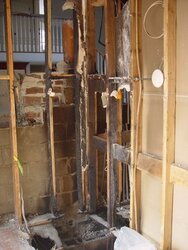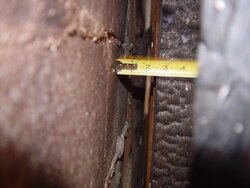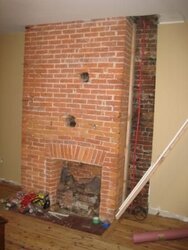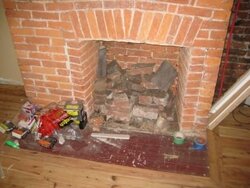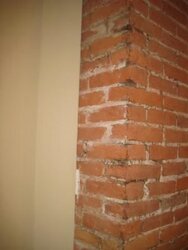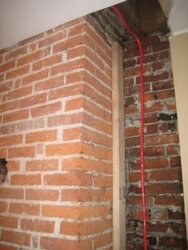- Sep 14, 2007
- 7
Hi, I've been looking on previous threads but still need help.
I had a chimney guy come and help vent my furnace a month ago. I also had him look at my newly discovered fireplace (Behind plaster) on the second floor of my 150 year old house. The chimney has a slight curve to the right and then goes up through the third and fourth floor dormer. You can see the whole chimney exit looking up from the second floor. It is completely unlined. He said that he would send down an 8" stainless steel liner (the opening is 14 by 17) to the second floor, break into the brick around the top of my firebox (if that is the appropriate term) and seal the liner - I assume by inserting a plate. He would also send down a stainless steel liner partway down the chamber of my furnace which is also unlined, again - I assume he would seal it using a plate. He would do all of this for 2200.
Fast forward one month. I researched chimneys and had some questions re: the instalation. He came again today and this time, personally (as opposed to an assistant) went on the roof and looked at the situation. His solution this time is to put in a steel rod 10 feet below the top of the chimney and drop terra cotta down to that level. He would put a cap/damper on the top. When I asked him why he suggested a ss insert last time and now he's telling me something different, he said that now that he is looking at the chimney himself and sees that it is in pretty good shape except for the top interior, there is not as much of a need to go all the way down. It will save me money to do it this way - 1200 quote. I asked him about code and insurance and without going into detail told me that it wouldn't be a problem. When I asked about insulation, he said that he would "seal" the bottom where the plate goes in if we went w/ the ss insert. BTW this guy came recommended by Angies list.
Now on to my many questions.
Can my chimney be unlined from the fireplace up approx 20 feet until the terra cotta kicks in?
Are there any code/insurance/safety issues I need to be concerned with?
My fireplace is only 13 inches deep. I'm a little worried about draft. As I mentioned the inside of the chimney is 14 by 17". The opening is 32 by 26 (832 inches SQ). I believe the terra cotta would be 11 by 14 (154 inches sq.) The 8" liner would be 16pi or 50 sq inches (right)? Should this impact my decision?
I'm used to seeing a door or flue at the top of the fireplace but there is no plan for one by the chimney guy. Do you need one?
What should I do?
I had a chimney guy come and help vent my furnace a month ago. I also had him look at my newly discovered fireplace (Behind plaster) on the second floor of my 150 year old house. The chimney has a slight curve to the right and then goes up through the third and fourth floor dormer. You can see the whole chimney exit looking up from the second floor. It is completely unlined. He said that he would send down an 8" stainless steel liner (the opening is 14 by 17) to the second floor, break into the brick around the top of my firebox (if that is the appropriate term) and seal the liner - I assume by inserting a plate. He would also send down a stainless steel liner partway down the chamber of my furnace which is also unlined, again - I assume he would seal it using a plate. He would do all of this for 2200.
Fast forward one month. I researched chimneys and had some questions re: the instalation. He came again today and this time, personally (as opposed to an assistant) went on the roof and looked at the situation. His solution this time is to put in a steel rod 10 feet below the top of the chimney and drop terra cotta down to that level. He would put a cap/damper on the top. When I asked him why he suggested a ss insert last time and now he's telling me something different, he said that now that he is looking at the chimney himself and sees that it is in pretty good shape except for the top interior, there is not as much of a need to go all the way down. It will save me money to do it this way - 1200 quote. I asked him about code and insurance and without going into detail told me that it wouldn't be a problem. When I asked about insulation, he said that he would "seal" the bottom where the plate goes in if we went w/ the ss insert. BTW this guy came recommended by Angies list.
Now on to my many questions.
Can my chimney be unlined from the fireplace up approx 20 feet until the terra cotta kicks in?
Are there any code/insurance/safety issues I need to be concerned with?
My fireplace is only 13 inches deep. I'm a little worried about draft. As I mentioned the inside of the chimney is 14 by 17". The opening is 32 by 26 (832 inches SQ). I believe the terra cotta would be 11 by 14 (154 inches sq.) The 8" liner would be 16pi or 50 sq inches (right)? Should this impact my decision?
I'm used to seeing a door or flue at the top of the fireplace but there is no plan for one by the chimney guy. Do you need one?
What should I do?


